Cool Jobs: A whale of a time
Scientists must find clever ways to probe the behaviors of leviathans that are — quite literally — out-of-sight
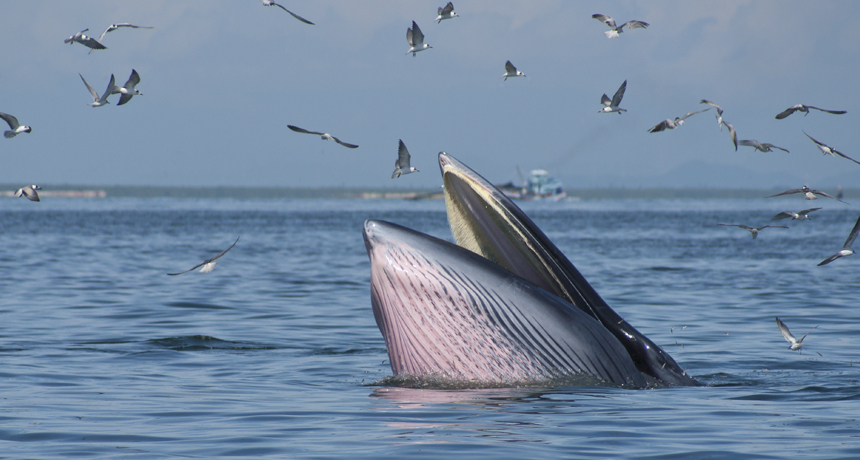
Here’s a whale cavorting in its feeding grounds off of Thailand.
JoyfulThailand /iStockphoto
By Eric Wagner
There is nothing quite like seeing a whale. From the comfort of a boat at sea, eager whale watchers might hope for a glimpse of a humpback hurling its 45-ton body out of the water. Perched on a cliff with a spotting scope, overlooking the Pacific Ocean, others may keep an eye out for gray whales as they migrate from feeding areas to breeding areas.
Such views capture only the tiniest glimpses of whaledom. And that’s because the bulk of a whale’s life takes place nowhere near the water’s surface.
Scientists who want to study cetaceans (the order that includes whales, dolphins and porpoises) cannot always keep a trained eye on them. So these experts must figure out other ways to follow what these marine mammals are doing. Attaching a small tag to a whale that uses satellites to track its movements, or using specially trained dogs to sniff for whale poop, are some of the many clever ways to do this.
Kelly Benoit-Bird at Oregon State University, in Corvallis, tracks her subjects with sound. It travels through water much better than light does. So, as a marine bioacoustician (BY-oh-ah-KOO-stih-shun), she studies biology (in this case cetaceans) with acoustics (sound signals).
She beams pulses of sound into the water. When they strike something solid — such as a dolphin, fish, squid or a cloud of microscopic animals called zooplankton — the sound bounces back to her boat. There, a computer translates the returning signals into an image made up of bands, smears or dots of various colors. The technology is called sonar.

In this story, we will learn more about Benoit-Bird and two other scientists who are peering into the secret lives of cetaceans. These scientists work with both living and dead animals. The data they amass are helping answer some of the most pressing questions of whale and dolphin biology. These include how and what these mammals eat, as well as what threats they face. Through careful sleuthing, their work adds to our increasing interest in, and concern for, some of the largest animals ever to have lived on Earth.
Seeing with sound
The sea has fascinated Benoit-Bird from childhood. She always knew she wanted to study it. So when she went to college — the first person in her family to do so — she majored in aquatic biology. Later, for even more advanced study, she headed to the University of Hawaii. Its graduate school has a large program that focuses on marine mammals.
In Hawaii, she started studying spinner dolphins. About the size of an adult human, these animals get their name from the fact that they spin through the air along their long axis as they leap from the water. The dolphins look a bit like footballs as they rotate in flight. No one knows why these dolphins do that.
Spinner dolphins, like many dolphin species, fish for prey in groups. Although this was well known, scientists didn’t really understand how the dolphins did it. Acoustics helped Benoit-Bird uncover their secret.
When filled with air, a spinner dolphin’s lungs reflect sonar well. Within the sonar signals, Benoit-Bird looked for any incredibly intense echoes that would indicate a dolphin’s lungs. She marked each dolphin with a yellow dot. The dots allowed her to track the dolphins individually as they moved within the cloud of other echoes from their prey.
|
This video animation shows the patterns in how spinner dolphins hunt fish in an orchestrated group. Benoit-Bird used sonar to tag individual dolphins. That allowed her to follow the marine mammals as they used teamwork to forage deep in the ocean. Oregon State Univ. |
As Benoit-Bird sat staring at her computer screen, she witnessed groups of as many as 28 dolphins lining up to approach a swarm of fish. Like sheepdogs, they herded the fish closer and closer together. Once the swarm grew very dense, the dolphins then formed pairs and started swimming in great circles around it. That action kept the fish corralled together. Finally, each pair of dolphins took turns dashing into the whirling mass of fish to grab a mouthful. After five minutes, they stopped to take a breath at the surface.
“Kelly was really creative in the way she approached the problem,” says the University of Hawaii’s Whit Au, who supervised her research. “And she was able to show something really neat.”
Her current work focuses on a variety of species, ranging from giant whales to tiny zooplankton — microscopic animals that drift through the seas. Benoit-Bird designs and builds many of the tools she uses. (Her dad was an auto mechanic and she grew up fiddling with tools in his garage. “You could say that I have a background in tinkering,” she explains.)
Lately, that work has had her testing — and tinkering with — a small submarine that she can program so that it pilots itself. It will let her look at how whales and their prey behave in even deeper water. Her spinner dolphin studies looked at dolphin behavior just 45 meters (150 feet) below the surface. The submarine, which looks like a torpedo, can extend her studies to depths of 600 meters (almost 2,000 feet).
Benoit-Bird says she always goes in asking the same thing: “How come things are found where they are? And so what?” Each answer that she takes home is like a puzzle piece. Over time they may assemble what she calls “the full picture.”
With the first of the next two scientists profiled here, often there is only a single puzzle piece to work with.
Wax of the whale
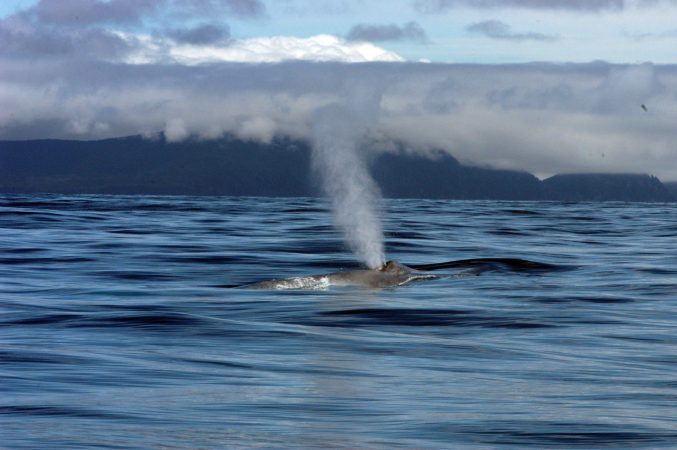
A team from the Santa Barbara Museum of Natural History quickly drove over to dissect it. The museum team removed several of the whale’s organs. They also collected something — earwax — that later would help them figure out the whale had been a young male in its prime.
Wait, earwax?
Just like you, whales have earwax. But unlike you, a blue whale can’t clean its ears with cotton swabs. Nor does it even have a visible outer ear, called a pinna. So over time the wax just builds up. The freighter’s victim had a plug of wax 25 centimeters (almost 10 inches) long. It looked like a stick, felt a bit like a candle and smelled pretty rank.
What’s more, the wax’s color wasn’t uniform. And that’s because its color varies depending on what the whale had been doing when it produced it. For instance, during that part of the year when whales focus on feeding, they make lighter-colored wax. While migrating, they make dark earwax.
This particular plug of whale earwax might have been forgotten if Stephen Trumble hadn’t wanted a cup of coffee one day. A physiologist at Baylor University, in Waco, Texas, he studies how body parts function. Or, as Trumble puts it, “It’s a way of looking at how animals work — how they do what they do.”
Trumble studies many aspects of physiology in marine mammals. This can range from how they digest their food to what happens to their bodies as they dive. He also studies how whales age. And while he was getting that cup of coffee with Sascha Usenko, an environmental chemist also at Baylor, Usenko asked Trumble how exactly the biologist calculated a whale’s age.
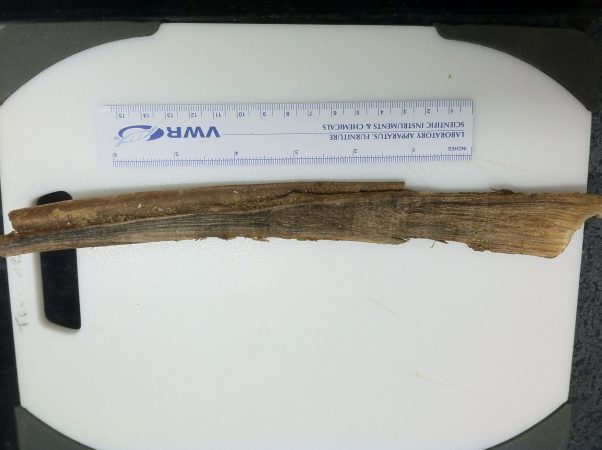
The trick is to study its earwax, Trumble answered. Like a tree, the wax has rings, he explained. Unlike a tree, a blue whale’s earwax gets a new ring every six months. So to calculate a whale’s age in years, you simply count the rings and divide by two.
Usenko then wondered aloud what other information that wax might hold. Tree rings, for example, also can record whether a tree lived through a wet or a dry year, or even a forest fire. Maybe a whale’s earwax could sum up its life story too, he reasoned.
“Ding!” Trumble recalls. “It was like a bell went off.” In fact, this made so much sense that he and his colleagues immediately went to work investigating. It took them two years to get their methods right. But when they did, they were able to use the earwax to write a short biography of the blue whale.
Its earwax contained traces of the pollutants to which the 12-year-old male had been exposed. It also contained traces of hormones the whale’s own body had produced. (Hormones are chemicals that an organism makes to turn on important biological functions.) It turned out that these hormones changed from one year to the next.
The earwax showed that the whale had been exposed to at least 42 different pollutants. These included everything from flame-retardants and toxic methyl mercury, to the insecticide DDT. (The United States banned DDT in 1972; since 2004, much of the rest of the world also has banned it. So Trumble now wonders whether the whale became exposed to that DDT from accumulations that his mother passed along in her milk.) That earwax also showed that three years before it died, the whale had reached sexual maturity. That’s when the guy’s testosterone levels spiked.
In the past, to find out what pollutants a whale had picked up, scientists had to remove tiny plugs of its tissue. That’s called a biopsy. (They do this by shooting a live whale with a special type of dart.) Earwax isn’t as easy to get, Trumble says, but it gives scientists more material to work with. And by measuring pollution in each six-month accumulation of earwax, scientists can track when an animal was exposed to some pollutant. The same is true for hormones. Biopsies, in contrast, can show only how much of some chemical a whale encountered cumulatively over its entire life. “The precision that the earwax allows is unprecedented,” Trumble says.
|
In this video, Trumble and Usenko discuss how they are using the earwax of whales to learn more about the animals’ life histories. Baylor Univ. |
For that reason, he says, earwax “is a new tool in our conservation toolbox.” That’s why he’s looking to try it with other species of whales. Luckily for him, museums throughout the world have hundreds of samples.
Trumble next looks forward to analyzing a plug of earwax in his freezer that came from a bowhead whale. Scientists have data suggesting these Arctic dwellers can live for more than 200 years. This might explain why the earwax in Trumble’s freezer is almost 60 centimeters long and weighs one kilogram (2.2 pounds).
In that sense, Trumble is lucky: He needs just a single piece from a dead whale to reconstruct at least a portion of the full puzzle of its life. Our next scientist isn’t so lucky. He might study a whale broken into 1,000 pieces. He has to painstakingly find each piece — and do so without gagging on a stench far worse than anything you can imagine.
The puzzle master
Biologist Andrew Trites considers himself a sort of detective. He approaches scientific problems as if they were mysteries to be solved. (Maybe this is because he read The Hardy Boys novels as a kid growing up in Nova Scotia, Canada.) Often, the real-life mysteries he tackles have something to do with populations of animals that are in trouble. He might investigate why there are fewer sea lions in a region, or why killer whales are declining in the Pacific Northwest.
For Trites, as with Benoit-Bird and Trumble, finding answers requires uncovering individual pieces and then figuring out how they fit together. And that’s because ordinarily, as Trites says, “You don’t have a body to look at.”
Sometimes, though, you do.
Trites is director of marine mammal research at the University of British Columbia in Vancouver, Canada. A few years ago, he moved into a new campus museum with a huge windowed atrium. Trites thought it would be neat to fill the atrium with skeletons hanging from the ceiling. He imagined whales swimming through the space. Or maybe sea lions. “It would look really cool,” he thought. What he wanted more than anything was the skeleton of the largest animal to ever live: a blue whale.
“They’re endangered,” Trites notes, “so they’re not only hard to find alive, they’re also hard to find dead.” Just by chance, though, while he was in Ottawa, Canada, he asked a colleague whether she had a spare blue whale skeleton in need of a home. The woman didn’t. She did happen to know, however, of an adult female blue whale that had been buried on Prince Edward Island 20 years earlier. (Scientists think a ship struck and killed the whale.) No one had touched its remains, she said. Did Trites want it?
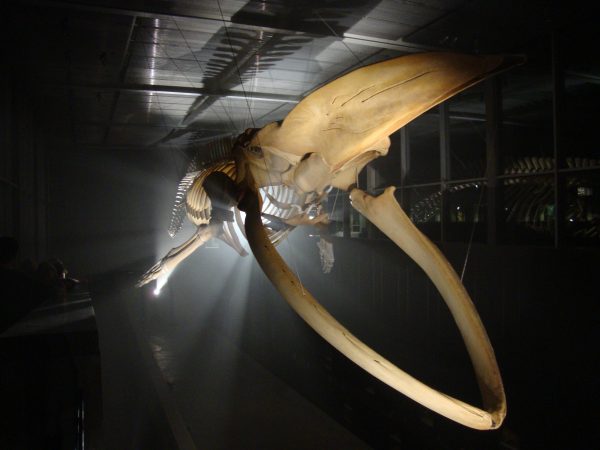
Indeed he did. A few months later, in mid-December, he and three other people flew the nearly 6,000 kilometers (about 3,700 miles) across Canada to Prince Edward Island. They wanted to inspect the whale’s condition. It was bitterly cold when they arrived. Worse yet, no one knew exactly where the whale had been stashed.
“We only had a crude map,” Trites recalls. “It was like a treasure map with an X on it.” So his team started digging holes in the snow-covered red soil. It wasn’t too long before they unearthed the carcass — and something else besides. Oh, the stench. “Imagine the worst thing you’ve ever smelled, and then multiply it by a thousand,” Trites says.
And things would only get far more gross.
The people who had originally found the carcass recognized it might have value to science one day. But they had nowhere to take the enormous mass of decomposing flesh and bone. So they reasoned that if they buried the whale, the bacteria in the soil would break down its flesh. In short order, only its bones would be left.
They were wrong. To Trites’ dismay, the whale’s blue skin hadn’t disappeared, but had remained largely intact. Essentially, it was one mammoth bag of stink. Imagine a sac about eight meters (25 feet) in diameter and more than 25 meters (85 feet) long. “I thought I knew what big was,” Trites says, “but nothing prepared me for the size of the animal! It went off in all directions. I was asking, ‘What have I gotten myself into?’”
Trites and his team returned the following spring to dig up the animal. As gross as the work was, Trites had no shortage of volunteers. “It’s just amazing, the number of people who wanted to help,” he recalls.
Like a colony of ants, the volunteers swarmed the whale. They cut and peeled away all of its skin, blubber and flesh. They cleaned the bones as best they could. Then they put everything on a huge, refrigerated truck for the long drive west, back across Canada to Vancouver.
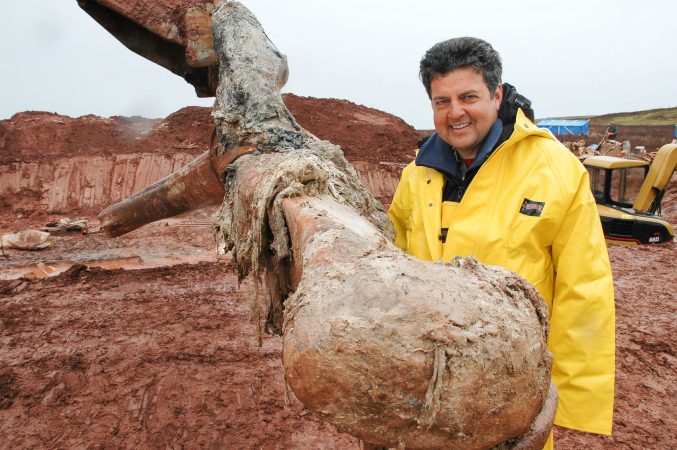
There Trites and his team would spend two years cleaning and reassembling the skeleton. Many of its bones were broken and needed repairing. The scientist had expected to find 180 bones. He wound up instead with more than 1,000 bones and bone fragments. His team even found this animal had an extra rib (which showed how much individuals of a species can vary). And each bone had to be treated so that it wouldn’t later stink up the entry hall to the new museum.
There were times, especially when the smell got really bad, that Trites questioned whether his dream was worth the yuck factor. But by 2012, his team had finished its work: A beautiful and complete blue whale skeleton now swims through the air on the university’s campus.
As scientists, Trites says, “We are trained to solve problems.” And they come in many forms. With whales and dolphins, those problems can require figuring out how to watch them hunt deep in the ocean, far from view. Or probing how and when a whale becomes exposed to pollutants. It might even require brainstorming how to inspire awe and wonder at some of Mother Nature’s most extreme life forms. Solving each problem requires individual ingenuity, and general persistence.
At its root, the challenge in each case is the same, Trites says: to understand the lives of animals that are ecologically important, even if we see them only rarely.
Power Words
acoustics The science related to sounds and hearing.
aquatic Having to do with water.
bioacoustics The branch of science that studies sounds either made by or affecting animals.
biopsy The examination of tissue taken from a living animal to see whether it is sick, or otherwise has some physical ailment.
blubber The thick layer of fat under a marine mammal’s skin that helps it stay warm even in cold waters. In the past, whalers would boil whale blubber to extract oil, which had many industrial uses.
bowhead A type of baleen whale that lives in the high Arctic. Roughly 4 meters (13 feet) long and 900 kilograms (2,000 pounds) at birth, it grows to an enormous size and may live well over a century. Adults can span 14 meters (40 feet) and weigh up to 100 metric tons. They use their massive skulls to break through ice to breathe. Lacking teeth, they sieve the water, straining out tiny plankton and fish to sustain their huge size.
blue whale A species of baleen whale(Balaenoptera musculus) that is the largest animal ever known to have existed. They can grow to lengths of 30 meters (almost 100 feet) and weigh up to 170 metric tons.
carcass The body of a dead animal.
cetaceans The order of marine mammals that includes whales, dolphins and porpoises. The baleen whales (Mysticetes) filter their food from the water with big baleen plates. The remaining cetaceans (Odontoceti) include some 70 species of toothed animals that include beluga whales, narwhals, killer whales (a type of dolphin) and porpoises.
DDT (short for dichlorodiphenyltrichloroethane) This toxic chemical was for a time widely used as an insect-killing agent. It proved so effective that Swiss chemist Paul Müller received the 1948 Nobel Prize (for physiology or medicine) just eight years after establishing the chemical’s incredible effectiveness in killing bugs. But many developed countries, including the United States, eventually banned its use for its poisoning of non-targeted wildlife, such as birds.
dolphins A highly intelligent group of marine mammals that belong to the toothed-whale family. Members of this group include orcas (killer whales), pilot whales and bottlenose dolphins.
graduate school Programs at a university that offer advanced degrees, such as a degree Master’s or PhD. It’s called graduate school because it is started only after someone has already graduated from college (usually with a four-year degree).
hormone A chemical produced in a gland and then carried in the bloodstream to another part of the body. Hormones control many important body activities, such as growth. Hormones act by triggering or regulating chemical reactions in the body.
humpback A species of baleen whale (Megaptera novaeangliae), perhaps best known for its novel “songs” that travel great distances underwater. Huge animals, they can grow up to more than 15 meters (or around 50 feet) long and weigh more than 35 metric tons.
mammal A warm-blooded animal distinguished by the possession of hair or fur, the secretion of milk by females for feeding the young, and (typically) the bearing of live young.
marine Having to do with the ocean world or environment.
mercury Sometimes called quicksilver, mercury is an element with the atomic number 80. At room temperature, thissilvery metal is a liquid. Mercury is also very toxic.
pesticide A chemical or mix of compounds used to kill insects, rodents or other organisms harmful to cultivated plants, pet or livestock, or unwanted organisms that infest homes, offices, farm buildings and other protected structures.
physiology The branch of biology that deals with the normal functions of living animals and their parts.
plankton A small organism that drifts or floats in the sea. Depending on the species, plankton range from microscopic sizes to organisms about the size of a flea. Some are tiny animals, called zooplankton. Others are plantlike organisms, called phytoplankton. Although individual plankton are very small, they form massive colonies, numbering in the billions. The largest animal in the world, the blue whale, lives on plankton.
physiology The branch of biology that deals with the everyday functions of living organisms and how their parts function.
phytoplankton Sometimes referred to as microalgae, these are microscopic plants and plant-like organisms that live in the ocean. Most float and reside in regions where sunlight filters down. Much like land-based plants, these organisms contain chlorophyll. They also require sunlight to live and grow. Phytoplankton serve as a base of the oceanic food web.
pinna The visible outer ear in humans and other mammals.
testosterone Although known as male sex hormone, females make this reproductive hormone as well (generally in smaller quantities). It gets its name from a combination of testis (the primary organ that makes it in males) and sterol, a term for some hormones. High concentrations of this hormone contribute to the greater size, musculature and aggressiveness typical of the males in many species (including humans).
sonar (short for sound navigation and ranging) A system that detects objects underwater by emitting sound pulses and measuring their return after being reflected.
zooplankton Small animals that drift or float in the oceans. They include single-celled animals, as well as the eggs and larvae of some larger animals, including crabs and lobsters.








